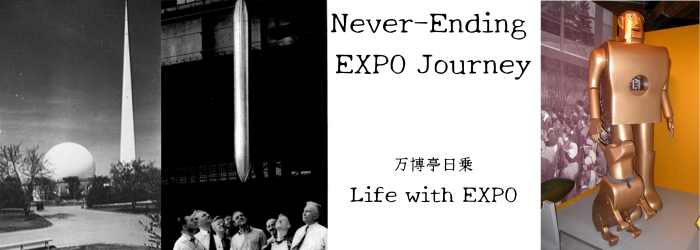Meiji era Art Capriccio
Well, this essay is about the Seikado Bunko Museum (Seikado @ Marunouchi).
Seikado is an art museum founded by Iwasaki Yanosuke and Iwasaki Koyata, younger brothers of Iwasaki Yataro, the founder of the Mitsubishi Group. (Please see the official website for details.)
In October 2022, the 130th anniversary of its founding, it began exhibition activities on the 1st floor of a national important cultural property Meiji Seimei Building in Marunouchi, Tokyo.
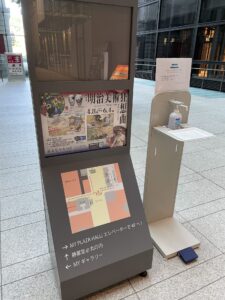
「明治美術狂想曲」パネル Panel of “Meiji era Art Capriccio”
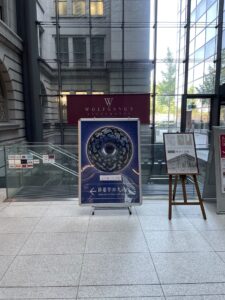
「明治美術狂想曲」パネル
Panel of “Meiji era Art Capriccio”
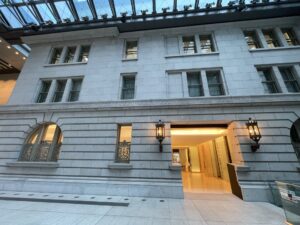
静嘉堂@丸の内入り口付近
Entrance of Seikado@Marunouchi
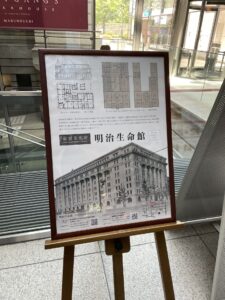
「明治生命館」パネル
“Meiji Seimei Kan” Panel
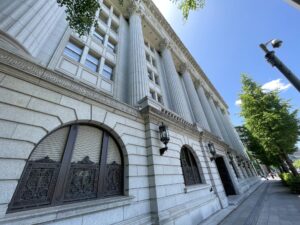
「明治生命館」外観
Exterior of “Meiji Seimei Kan”
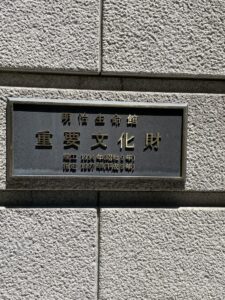
「重要文化財」の標識
Sign of “Important National Cultural Property”
This time, I visited a special exhibition called ” Meiji era Art Capriccio“.
The exhibition was held from Saturday, April 8, 2023 to Sunday, June 4, 2023.
This is a space that opened last year in the Marunouchi business district. It is not so large in scale and is a valuable museum that can be easily visited.
I visited last year’s open exhibition, and saw “Yohen Tenmoku,” which was also on display this time.
Well, this time, I decided to visit with the expectation that there might be something related to overseas World Expositions in the Meiji era.
After all, it is full of highlights, including the regulars of the Expo exhibition.
The word “Bijutsu” was coined!
The “Chapter 1” of this exhibition is titled “The Birth of ‘ Bijutsu’ –Between Edo and Meiji”.
According to the catalog, this “Chapter 1” is as follows.
*
In 1873 (Meiji 5), the word “Bijutsu” was coined when the new government translated the exhibition rules for the Vienna World Exposition. It was the birth of “Bijutsu,” which is still widely used today.
*
During the Meiji period, various foreign languages were “translated” into kanji in Japan, and the 1873 Vienna World Exposition was the catalyst for the creation of one of them, ” Bijutsu (Fine Art).”
When I looked it up on the internet, I found a document by Mr. Ishii Takuhiro of Joshibi University of Art and Design. According to the document, “History of the Word ‘Bijutsu’ – When was the Japanese word ‘Bijutsu’ born? What did it originally refer to?”
This material is based on Takashina Shuji’s ” Bijutsu” and “Britannica International Encyclopedia 16”.
Quoted below. “*” is a supplement or idea by Mr. Ishii.
*
・”It was a translation from English, and it is said that Keisuke Ootori (*Western military scholar, bureaucrat, diplomat) came up with this translation.”
・The first time the word “Bijutsu” appeared in Japan was in 1872, when an official decree was issued to invite the public to participate in the Vienna World Exposition.
・”The art of making music, imagery, and poetry is referred to as ‘Bijutsu’.”
・”The technique of creating images of music and images, poetry, etc. is said to be ‘Bijutsu’” (* Meiji 5, 1872, government ordinance)
(*Music, the technical work of creating pictures and statues, and the creation of poetry are called ‘Bijutsu’.)
“What is interesting is that, as is evident from the note in the decree quoted,
Originally, ‘Bijutsu’ was understood to mean ‘art’ as a whole, including ‘music’ and ‘poetics’.
・”This (*the fact that ‘Bijutsu’ meant ‘art’ as a whole) would correspond to the extremely broad meaning of the English term Fine Art in the latter half of the 19th century.”
“However, in 1877 (Meiji 10), five years after its first appearance, ‘ Bijutsu’ already had almost the same meaning as it does today.”
*
I tried to find the original of this “official decree (which) was issued to invite the public to participate in the Vienna World Exposition”, but I couldn’t find it on the internet. Maybe I’ll have to try next time at the National Diet Library or somewhere.
Kawanabe Kyosai (1831-1889)’s “Hell and Paradise Tour” (1869-72)
The eye-catching work in this first chapter is Kawanabe Kyosai‘s (1831-1889) “Jigoku Gokuraku Meguri-zu (Hell and Paradise Tour)”.
The catalog (P11) says:
*
Tatsu, the daughter of Gohei Katsuta, a haberdashery wholesaler in Nihonbashi, Edo (her family crest is Omodaka), passed away prematurely at the age of 14 on March 10, 1869 (Meiji 2).
This work is a picture album that Katsuta commissioned Kawanabe Kyosai (1831-1889) to hold a memorial service for her.
Guided by the Amida Sanzon, whom Tatsu came to welcome her, she tours various places in the underworld, reunites with her ancestors, etc., and depicts the process of reaching paradise and rebirth.
*
As a result, it is a picture album consisting of many pictures, such as crossing the Sanzu River, enjoying a play, visiting various places, arriving at paradise and rebirthing.
It is a work that conveys the painful feelings of her father who lost her beloved young daughter.
After her death, we can feel he father’s wish that she should go to paradise while enjoying various things such as theater.
By the way, this Kawanabe Kyosai is also a painter related to the Expo.
The Bunkamura website has a page called”What is Kawanabe Kyosai ?”
According to this chronological table of Kawanabe Kyosai, in 1873 (Meiji 6), it is as follows;
*
To exhibit at the Vienna World Exposition
He also drew a picture of “Taka, Hebi, Kiji no ai-kuwantosuru zu (a falcon, a snake, and a pheasant eating together)”.
However, it was not completed by the due date.
But, he, at the request, produced the large banner “Empress Jingu, Illustration of Takenouchi Sukune“, for the decoration of the exposition.
*
Also, in 1876 (Meiji 9), there is the following description.
*
“Biwa-su Birds” at the Philadelphia World’s Fair
Exhibited “Chusei Kagi no Zu“. (Picture of Medieval Geisha)
*
Also, in this catalog, it says;
*
It is also known that the British architect Josiah Conder, who designed the residence of the Iwasaki family, became a disciple.
*
Josiah Conder (1852-1920) came to Japan during the Meiji era and taught Western architecture at the current Faculty of Engineering, University of Tokyo.
He designed “Rokumei-Kan“, “Nicholai-do“, ” Mitsubishi Ichigo Kan“, and others.
It is quite an interesting episode that such a person was apprenticed to Kawanabe Kyosai.
By the way, it seems that every Saturday was a practice day.
Shibata Zeshin, “ Hen-Nuri Ekae-don gai ” (1873)
Next on display is Shibata Zeshin‘s ” Hen-Nuri Ekae-don gai ” (1873). <Actually I’m not sure how to pronounce the name of this works…>
Shibata Zeshin (1807-1891) is a lacquer artist and painter active from the late Edo era to the Meiji era, according to a catalog.
In this ” Hen-Nuri Ekae-don gai “, lacquer is used to express “not only the wood grain, but even the ants walking on the lid are expressed with lacquer art” (from the catalog). It is a transcendental technique that surprises the lacquerware.
Shibata Zeshin “exhibited five works including ‘Fuji Tagoura Maki-e Frame‘ at the Vienna World Exposition in 1873″ (from the catalog)
So, he was also a person who exhibited at the Expo.
In this exhibition, in “Chapter 2”, there are several inro made by Shibata Zeshin, and in “Chapter 3”, “Yanagi-ryusui Maki-e Jubako” was on display.
In fact, Shibata Zeshin’s work “Senmen Maki-e Kazari-dana” (1889) was also exhibited at the exibition titled,
Commemorating The 2005 World Exposition, Aichi, Japan
Arts of East and West from World Expositions 1855-1900 : Paris, Vienna and Chicago
which was held in Tokyo, Osaka, and Nagoya from 2004 to 2005.
The commentary at that time (P130 of the art exhibition catalog of exhibition) is as follows;
*
In the Meiji era, many maki-e artists used other painters’ designs to complete their works, but Shibata Zeshin, who was a painter, created works based on his own designs. (Omission) It is noteworthy that Zeshin was able to complete and exhibit a maki-e frame at the Vienna World Exposition, the first official participation to a World Expo of the Japanese government for the first time. (Omitted below)
*
By the way, this ” Senmen Maki-e Kazari-dana” was created when Zeshin was 83 years old, and is in the possession of Sano Tsunetami, who was the vice president of the “Okoku (Austria) Expo Secretariat” on the Japanese side of the Vienna Expo (the president was Okuma Shigenobu).
By the way, works of Shibata Zeshin were exhibited at the Vienna World Exposition in 1873 and won the “Progress Award“.
After that, he exhibited at the 1876 Philadelphia World’s Fair and won a medal, and also exhibited at the 1889 Paris Universal Exposition and won a gold medal.
(According to @Press “Seitei, Kyosai, Zeshin – Paris Philadelphia World Exposition, Japanese art in the Meiji era beyond the sea” (https://www.atpress.ne.jp/news/254101))
What is the ‘Progress Award’ at the 1873 Vienna World Exposition?
By the way, what is the “Progress Award” at the 1873 Vienna World Exposition?
In fact, the system of gold, silver, and bronze medals is said to have been institutionalized by Napoleon at the 2nd French National Exposition in 1801 for the first time, not the modern Olympics. It was inherited by the World Expositions, and baron de Coubertin took a hint from it and incorporated it into the modern Olympics.
By the way, at that time, the prize system was determined by each Expo.
For example, at the first London Great Exhibition of 1851, two types of medals were enacted in terms of recognition: the Council Medal and the Prize Medal. (See story <17>)
At the 1855 Paris Universal Exposition, the medals of “Gold”, “Silver”, “Bronze” and “Honorable Mention” were awarded, but as a result, the “Grand Prix” was established above them.
At the Vienna World Exposition of 1873, five types of medals were set: “Art,” “New Taste,” “Progress,” “Cooperation,” and “Honor.”
“Progress Award” that Zeshin Shibata was awarded was one of these five types.
Later, at the 1876 Philadelphia World’s Fair, it had only one type – “bronze medal.” Therefore, the “medal” of the above “exhibited at the 1876 Philadelphia World’s Fair and won a medal” means that he won a “bronze medal”, which was set to only one type.
Other Expo-related exhibits
In addition to the above, there are other exhibitions related to the World Expo in this exhibition.
First, “ Satsuma-yaki Iro-e Kinsai Shishi Botan Kouro” (around 1876).
According to the description of the catalogue, it says, “a work very similar to this work was exhibited at the Philadelphia World’s Fair in 1876. It is now in the collection of the Philadelphia Museum of Art.”
I searched the website of the Philadelphia Museum of Art, but unfortunately I could not find an image of the work that seems to be it.
Next is Noguchi Yukoku’s (1827-1898) “Kiku Kei Zu Byobu (Chrysanthemum and Chicken Screen)” (1895).
According to the catalogu, “…it was exhibited at the Vienna World Exposition and the first National Industrial Exhibition in the Meiji period.” This painter, Yukoku Noguchi, also the artist who had experience exhibiting at the Expo.
In addition, works by Seifu Yohei III, Suzuki Chokichi, Togawa Sosuke, and Kuroda Seiki, who have already been introduced several times before, are also on display.
Suzuki Chokichi (1848-1919) exhibited “Twelve Hawks” at the 1893 Chicago World’s Fair.
*
・・・Became independent at the age of 18. In 1874, he became a foundry supervisor of the Kiriu Kosho Kaisha Company. In the 11th year of Meiji (author’s note: 1878), he won a gold medal at the Paris Universal Exposition for his large peacock incense burner (currently owned by the V&A Museum). . (Omitted below)
*
Regarding Kuroda Seiki, this time, the famous “Nude Woman Statue” which caused the “Koshimaki Incident” is exhibited. The catalog has the following explanation.
*
This work was painted during Kuroda’s second visit to Europe from 1900 to the following year. It is said that Kuroda’s works (“Wisdom, Impression, Sentiment”, etc.)exhibited at the Paris Universal Exposition that same year were criticized by Kuroda’s teacher, Raphaël Collin, and inspired him to paint this work. (Omitted) Kuroda recalls that perhaps because of his encouragement, Collin said, “Why didn’t you show this work at the exposition?” (Omitted below)
*
“Wisdom, Impression, Sentiment” won the silver prize at the Expo. But the works of Kuroda at the Paris Universal Exposition (which should include “Lakeside”) were unpopular to his master, Raphaël Collin (1850 -1916), and it seems that this “Nude Woman” was well received.
To be honest, I don’t really know the difference. I feel that I can also feel the influence of Renoir in this “Nude Woman”.
In any case, this work was exhibited at the 6th Hakubakai in 1901, but was exhibited with the lower body covered with cloth under the direction of the police. This is the famous “Koshimaki Incident” episode. It vividly expresses the allergy to nude paintings of the time.
